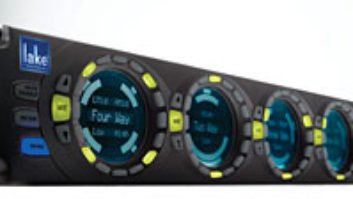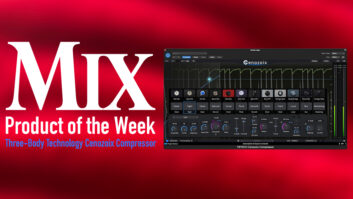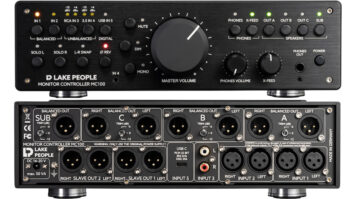
In 1997, representatives from Clair Brothers, along with a team of heavy-hitters in the digital world, joined forces to design the Clair iO, which ushered in the next generation of digital processors. Until now, the processor remained under the exclusive domain of Clair and Showco, and has become one of the most widely used processors in the high-end live sound market. Under the guise of Lake Technology, the processor, called the Lake Contour, is now available to the general public.
The Lake Contour is a crossover, delay, dynamics processor, equalizer and a DSP-based speaker controller. But the hardware and software set Contour apart from other processors. It features completely new filter concepts, high-quality components, an exceptionally clean signal path, a simple graphic interface and wireless control. While it is designed for live sound applications, Contour will also find a welcome home in the studio monitor market.
This 2-in/6-out box can be set up as two two- or three-way crossovers or as a single four-way. All internal processing is performed at 40-bit precision, and converters are 24-bit/96 kHz. Multiple boxes are linkable via Ethernet cables for total system control via one computer. This is handy when using two Contours for a stereo four-way system or three Contours on a two- or three-way 5.1 system. Parameters are stored in nonvolatile memory so if the Contour loses power during operation, then it returns to its exact pre-power-loss state. If a network communication problem occurs, then the sound output from Contour’s processors continues without interruption.
HARDWARE RUNDOWN
The rear panel has balanced I/Os, an AC power socket (internal auto-ranging power supply) and a 3-position ground switch. At the October AES show, Lake Technology debuted a digital input version; users with digital desks or DAWs can now get into Contour without conversion. Contour’s Iso-Float technology incorporates the benefits of transformer-coupled ground isolation while maintaining the advantages of clean, direct-coupled I/Os. The audio converters are galvanically isolated and not connected to the main ground. This technique uses high-speed transformers and opto isolators to create a barrier between the device and any grounding aberrations from the outside electrical environment. Two RJ-45s and an RS-232 data port handle PC-to-Contour communications and can link multiple Contours.
As the PC controller does most of the work, the front panel is simple, with a power switch and Select switch that identifies the unit on a network. Four alphanumeric characters show status information and let users name and quickly identify the individual units in a system. Also on the front panel are two co-ax connectors for 10Base2 (a 10MHz Ethernet system running over thin 50-ohm baseband cable) to link units together, along with another RJ-45 jack for quick computer connections. Having front and back access and link capabilities is really nice. Eight mute switches beneath the LED I/O level meters and status LEDs (for power, Ethernet communication and external control) complete the picture.
COMPUTER CONTROL
The control program runs on Windows 98, 2000 and XP, or you can use the tablet controller that Lake provides with the system. Lake recommends at least a 600MHz Pentium III (or equivalent), but a faster PC will let you feel the power and speed of the WiFi controller interface with speeds of up to 10 Mbps. While you would do well to use a touch screen tablet with WiFi to work with optimum ease and speed, it would be an expensive luxury for a studio install. The touch screen tablet is light weight, can be held in one hand while tapping out commands with a pen-style pointer and has many cool drag-and-drop-style functions. I also found that I could do everything I needed with a mouse-based computer. Sound system information is presented in color on the computer’s screen display. The controls are mostly intuitive, easy to learn and easy to understand. Not only can adjustments be made to any parameter of any Contour on the network, but they can also be made to selected “groups” of processors. A speaker can be a member of more than one group. Adjustments can be made in real time, giving the responsiveness of an analog unit. After extensively testing available wireless networking solutions, Lake found that performance varied significantly among 802.11b wireless vendors, so the company provides its own wireless networking package so that everything works right out of the box. Lake will also fully support users setting up their own wireless system.

There are many options when creating preferences, including storing, saving and recalling system configurations. Whether in a fixed sound system or studio, setup procedures need to be kept separate and safe by the installer, so two unique operating modes are provided. In the password-protected Designer mode, the installer adjusts all parameters and then limits access to system functions. In the User mode, the house engineer uses a streamlined interface where setup parameters are safely out of reach. A room could be calibrated and those controls locked out. Then, an X-Curve overlay could be created for film mixing or a personality curve could be implemented for a specific producer/engineer, application or event. These curves can be quickly recalled as needed. There is virtually no limit to the number of setups that can be stored and recalled.
Many live sound companies use SIA Software’s Smaart system to tune their sound systems. Lake has collaborated with SIA that results in a plug-in that will integrate with SmaartLive’s real-time analyzer, dual-channel impulse response (delay locator) and transfer function (frequency response) measurement capabilities. Smaart can run on the same computer as the Contour software or on another PC over the network. Just plug the Smaart computer into the Contour network with an Ethernet connection and Smaart will transmit its results to the Contour Controller computer.
FILTERS AND EQ
Contour synthesizes filters in real time, so it’s perfect for live performance, implementing a room setup with all of a sound system’s delay, EQ, crossovers and dynamics. A personality curve can be layered over that; later, additional filters can be imposed during a show to keep the system in trim. There is almost no limit to the number of EQ curves that may be generated, although the undereducated could potentially get into deep trouble with this kind of power. Lake is the first company to introduce an EQ overlay using a tabbed user interface. Each overlay has a vast number of parametric or graphic filters that contribute to the composite EQ curve.
The Contour Controller offers simultaneous parametric and graphic EQ overlays. Significant improvements have been achieved in both graphic and parametric filter design. EQ resolution is at 1/24th octave — more sophisticated than any existing hardware-based system. Lake’s “flat sum” Ideal Graphic EQs do not interact like traditional equalizers. As the name implies, adjacent bands sum flat, something that traditional ⅓-octave EQ cannot do. Lake uses raised cosine functions as opposed to traditionally implemented filters. This results in higher selectivity than traditional filters or, in other words, less bleeding into adjacent frequency bands. Examples of the advantages are shown in the figure.
Intended to supersede the traditional parametric, Lake’s proprietary Mesa Filter is a significant advance in EQ technology. Whereas other processors provide standard symmetrical boost/cut functions, the Mesa filter offers asymmetric filtering with the ability to separate the sides of a parametric section, change center frequencies and adjust slopes independently. This faster, more effective optimization tool is one that can truly match the loudspeakers’ asymmetrical response. It’s certainly a more elegant way to approach the X-Curve’s high-frequency roll-off. There have been occasions where I could have used a Mesa-style filter and added a small dip or boost in the middle of the “Mesa” through overlaying filters. To get a desired curve, the ability to adjust slopes independently means that there’s less chance of generating out-of-band boosts — which are typical of traditional parametrics — that can result in speaker distortion and overexcursion. This is also a great creative tool, giving engineers added levels of EQ sophistication.
CROSSOVERS
Contour offers an extensive selection of linear phase, traditional and nontraditional crossover filters. I liked having the vast array of traditional crossovers available while I worked on a four-way system that needed a lot of experimentation to get the crossovers right. The ability to quickly change slopes, crossover types and crossover frequencies makes Contour useful, even to speaker designers who build analog crossovers. In addition to a wide array of traditional filters, Lake introduces linear phase, brick-wall crossovers with transition slopes exceeding 100 dB/octave. For the linear phase brick wall crossovers, the user can choose from four amounts of “alignment delay”: 3.15 ms, 6.29 ms, 12.58 ms or 25.17 ms. By choosing a lower value for the alignment delay, the steepness of the crossover is reduced. For example, you can get 100dB per octave slopes at 1 kHz with an alignment delay of 6.29 ms. LIMITERS AND MORE
Contour offers true RMS and soft-clamp limiting with threshold and corner adjustments on each output. By calculating the true RMS value of every sample, the system produces acoustically transparent results, even under extreme limiting conditions. The soft-clamp limiter removes the possibility of clipping by gently removing audio peaks that would otherwise drive an amplifier to distort. The Levels screen includes other adjustable parameters, such as A/D input headroom, input/output gain and input/output delay. High-resolution, fast updating meters simultaneously show true RMS and peak levels with peak hold. Users can choose to meter from several points in the signal path. The faders have fine and coarse modes and most parameters can be adjusted within 1/100 dB. I would prefer a different graphic for the delay control, because it looks just like the level faders and thus differentiating the two can be confusing. USE IT OR LOSE IT
I found Contour’s capabilities deep but straightforward to use once I was familiar with them. Navigating around the controller is made easier due to the use of color-coded buttons. One Contour is considered a “frame” that has two “modules” representing inputs A and B. Modules and frames may be labeled and give the user a variety of setting information at a glance. Adjustments to the system can be made online or offline. Most of the adjustments are simply activated via a tap or drag-and-drop methods. Block diagrams ensure that you don’t lose your way through the complex signal path you design. Once I got used to the idea of using many layers, system setup went quickly. Accessing crossovers and EQ was fast and made simple with the extraordinary graphic interface. My one complaint is that it is too much fun to mess around with all of the parameters. It’s a good thing there wasn’t a client staring over my shoulder!
The Lake Contour is an excellent-sounding piece of gear and handles large and varied amounts of processing without apparent sonic problems. Just remember that, as with any digital processor, you are adding A/D and D/A conversion to your listening chain. Good graphics help guide you through the controls, but the system is a bit weak on how to get from point A to point B. The thorough manual is well-thought-out and does a pretty good job at teaching the box’s complexities. Lake now provides demo videos on the newest contour software CD-ROMs; contact Lake to get a copy. This is a very complex tool and certainly one that will add value and control to most sound systems. Be sure to give yourself some time to practice with the Contour in advance of your installation so that you can full advantage of its power.
Lake Technology, 415/861-1147, www.laketechnology.com.
Bob Hodas is a San Francisco Bay Area-based recording engineer and acoustical consultant.
CONTOUR IN CONCERT
A Monitor Engineer’s Perspective
By Peter J. Franco
I just got off the road mixing monitors for Paul Williams and Melissa Manchester. My FX rack included four Lake Contour units with the wireless pad remote PC controller. I configured each Contour Module to EQ-Only mode and inserted the Contours on eight of my groups on my console. The beauty of having wireless control in a live situation is that you can stand where the artist stands and not have to run back and forth. The Contour gives you a visual connection of what’s going on with each of your mixes, and you can monitor all your mixes at once or select the one you want to work on. I zero’ed in on frequencies quickly and efficiently by simply sweeping the pen across the screen. In Manchester’s vocal mix, I cut everything out below 500 Hz with the low-cut filter and got rid of a nasty 2.7kHz frequency by stacking two 0.1dB/octave filters on top of each other, giving me 30 dB of cut. Try that with a regular graph! I will never mix another act without the Lake Contour. It makes my job a lot easier and on top of that, it makes me look cool!




